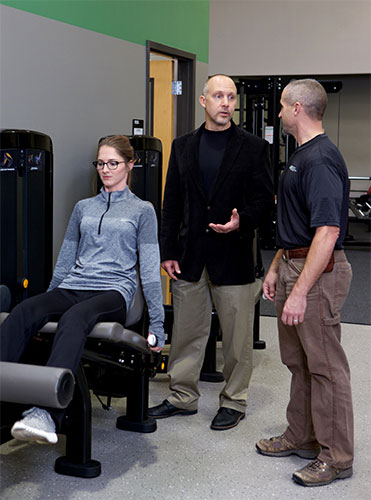 Marcas Bamman, Ph.D., center, will lead UAB's clinical center for the National Institutes of Health Molecular Transducers of Physical Activity Consortium, or MoTrPAC, initiative in exercise clinical trials to map the molecular underpinnings of health benefits.The University of Alabama at Birmingham Center for Exercise Medicine has been selected as a clinical center for the National Institutes of Health Molecular Transducers of Physical Activity Consortium, or MoTrPAC, to explore molecular changes that occur during and after exercise.
Marcas Bamman, Ph.D., center, will lead UAB's clinical center for the National Institutes of Health Molecular Transducers of Physical Activity Consortium, or MoTrPAC, initiative in exercise clinical trials to map the molecular underpinnings of health benefits.The University of Alabama at Birmingham Center for Exercise Medicine has been selected as a clinical center for the National Institutes of Health Molecular Transducers of Physical Activity Consortium, or MoTrPAC, to explore molecular changes that occur during and after exercise.
UAB and its two partners — the Translational Research Institute for Metabolism and Diabetes in Orlando, Florida, and Ball State University in Muncie, Indiana — will receive a projected $6.6 million over six years, as part of the nearly $170 million MoTrPAC initiative involving researchers across the United States.
The NIH announced all MoTrPAC awardees Dec. 13. The seven awarded MoTrPAC clinical centers include several partners, totaling 12 institutions nationwide. MoTrPAC is a national research consortium designed to discover and perform preliminary characterization of the range of molecular transducers (the “molecular map”) that underlie the effects of physical activity in humans. The program’s goal is to study the molecular changes that occur during and after exercise and ultimately to advance the understanding of how physical activity improves and preserves health. The program is the largest targeted NIH investment of funds into the mechanisms of how physical activity improves health and prevents disease.
The new clinical center is led by Marcas Bamman, Ph.D., director of the UAB Center for Exercise Medicine and professor in the Departments of Cell, Developmental and Integrative Biology and Medicine; Bret Goodpaster, Ph.D., from TRI-MD; and Scott Trappe, Ph.D., from BSU. Additional key team members include Gary Cutter, Ph.D., Lou Dell’Italia, M.D., and Mona Fouad, M.D., from UAB; Steven Smith, M.D., from TRI-MD; and Todd Trappe, Ph.D., from BSU. Together, these investigators comprise the Exercise and Physical Activity Collaborative Team, or ExPACT.
“We are certainly excited to help the NIH MoTrPAC meet its objective to assemble a comprehensive map of the molecular changes that occur in response to specific exercise prescriptions, which should substantially improve our understanding of the mechanisms by which exercise yields numerous health benefits,” Bamman said. “The NIH Common Fund’s investment into this research program speaks volumes about the importance and potential impact of this discovery effort. This is truly a groundbreaking opportunity for the field.”
“The MoTrPAC initiative is a moonshot opportunity for the exercise community, and the Human Performance Laboratory is honored to be part of the team,” said Scott Trappe, director of the BSU Human Performance Laboratory and Human Bioenergetics program. “This is the future, and it will move the field forward to better understand the health benefits of exercise.”
Nationwide, the trial is expected to enroll approximately 3,000 participants, with each center responsible for enrolling and studying 450–500 individuals using standardized procedures and common protocols. The NIH and a central coordinating center will manage the national effort. In addition to the clinical centers, MoTrPAC also involves several additional centers that will conduct the biospecimen analyses, data analyses and complementary studies in animal models.
“The trial design will incorporate comprehensive phenotyping to assess fitness and clinical outcomes, and human tissue phenotyping to link the molecular transducers with key biological responses to exercise training,” Cutter said.
NIH recognizes the need for a coordinated effort to assemble a comprehensive map of the proteins, peptides, circulating nucleic acids, lipids, hormones and other molecules that change during or after exercise. These are the signals that are most likely to convey the effects of movement throughout the body. In other words, they are probable “molecular transducers” of physical activity’s health benefits.
All the information will be stored in a publicly accessible database scientists can use to study almost every organ and tissue in the human body. Ultimately, the research findings resulting from this program could help scientists and clinicians define optimal physical activity recommendations for people at various stages of life, as well as develop precisely targeted regimens for individuals with particular health needs.
The MoTrPAC program is supported by the NIH Common Fund and is managed by a trans-agency working group representing multiple NIH institutes and centers, led by the NIH Office of Strategic Coordination, National Institute of Arthritis and Musculoskeletal and Skin Diseases, National Institute of Diabetes and Digestive and Kidney Diseases, National Institute on Aging, and National Institute of Biomedical Imaging and Bioengineering.